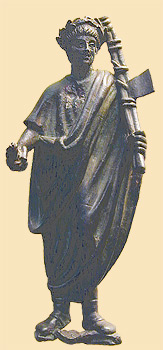
Lictor

Livy (Ab urbe condita 1.8) attributes to Romulus the institution, borrowed from the Etruscans, of 12 lictors, introducing these attendants upon the king in an effort to increase his dignity in the eyes of his subjects; lictors carried the fasces, an ax bound with red thongs to a bundle of elm or birch rods, as a symbol of the king's absolute power to seize and punish wrongdoers. During the Republic and into the Empire, any magistrate who possessed imperium (e.g., the consul, proconsul, praetor, military tribune, dictator) was alloted lictors, inside and outside of Rome, each one bearing the fasces. Their number and assignment changed over time, but not their responsibilities: they preceded designated magistrates in a single file (the first was the primus, the last was the proximus); they announced the magistrate and cleared the way for him; and they implemented the magistrate's right of arrest and punishment.
Here Umbricius points to the depths to which the position has sunk in the Rome of his day: rather than processing before his praetor in a stately manner, clearing the path and calling people's attention to the dignitas of his office, the lictor is propelled forward along empty pre-dawn streets by a praetor anxious to give the first greetings of a cliens to his wealthy patron.
Until the second century CE, when freedmen were admitted to the membership, lictors were required to be freeborn citizens, usually from the lower classes. They dressed in a toga in Rome, in a red sagum (a four-cornered military cloak) outside of Rome, and in black mourning clothes at funerals. Public servants of middling rank, they were organized into corporations (decuriae apparitorum), from whose officers they received their assignments.
Lictors without fasces accompanied the flamen dialis, the vestals, and the magistri vicorum; similarly outfitted were the 30 lictores curiati, who called the curiae to vote in the comitia curiata.
